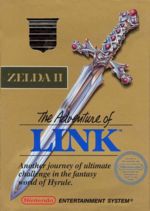Zelda II: The Adventure of Link

| |
| The Adventure of Link | |
| Full Title | Zelda II: The Adventure of Link |
| Developer | Nintendo |
| Publisher | Nintendo |
| System | NES, Game Boy Advance, Virtual Console, 3DS Virtual Console |
| Release Date | NES JP January 14, 1987 EU November 26, 1988 US December 1988 GBA JP August 10, 2004 US October 25, 2004 EU January 7, 2005 Virtual Console JP January 23, 2007 EU February 9, 2007 US June 4, 2007 3DS Virtual Console August 31, 2011 (Ambassador) |
| Genre | Adventure/RPG |
| Gallery | GH Gallery |
| Rating | ESRB: E |
Zelda II: The Adventure of Link is the sequel to The Legend of Zelda. It is the last Zelda game for the NES and is known for its very different gameplay style and for being harshly difficult.
Story
Long ago the King of Hyrule ruled the land wisely with the Triforce. After he died, he gave part of the Triforce to the prince, but not all. of it. When the prince found out his sister, Zelda, knew of it, he demanded her to tell him. When that did not work, the king's magician grew angry and cast a spell of eternal sleep on her. Though the prince banished the evil fiend, he was unable to help the princess.
It is now nearly Link's sixteen birthday and he is living happily in North Castle, after defeating Ganon in The Legend of Zelda. One day a strange mark appears on his hand. He shows it to Impa, and she tells him the Prince and the sleeping Princess. Since Link has both the Triforce of Power and Wisdom, she tells him of the Triforce of Courage's resting place. But the place where it rests, the Great Palace, is protected by a seal. In order to break the seal, Link has to return six crystals to the different palaces across the land. However, this quest will not be easy. Not only at the palaces protected by guardian creatures, but Ganon's minions are searching for Link and planning to use his blood to resurrect Ganon.
Gameplay
This game takes on a new style with elements from sidescrollers and traditional RPGs. Link navigates the overworld, and after entering certain areas or touching a monster that appears on the overworld map, he is transferred to a side-scrolling area where the player usually must fight off monsters. Instead of the traditional inventory of items and weapons, Link only fights with a sword in battles. Link can also jump, and there are a limited amount of items found within the game, most of which affect the overworld (such as the hammer, which can break rocks blocking paths). This game also adds a variety of magic skills that Link can learn from the wise old men living in the various villages, which are monitored by his amount of magic points. Link also gains experience and levels up, at which point the player can choose to increase his health, his magic meter or his strength. This is also the only Zelda game where Link has extra lives.
Continuity Notes
- This game specifically takes place several years after The Legend of Zelda with the same Link and Impa (although the ancient Zelda appears in pace of the Zelda of the previous game). Ganon's minions also seek to revive him due to his destruction at Link's hands in the previous game's ending. At the end of the game Link is also shown to still have the Triforces of Wisdom and Power from the previous game.
- A small portion of the overworld resembles a reduced version of the overworld from The Legend of Zelda, including Death Mountain. This has caused the expansive overworld that is exclusive to this game to be referred to as North Hyrule.
- This game sets several story precedents for the Zelda series, as it introduced the whole Triforce (with its last piece, the Triforce of Courage) and establishes multiple generations of Princess Zeldas. This has also caused confusion about the timeline placement of Zelda II's backstory, as the story of the sleeping Zelda is implied to have taken place at an early point in Hyrule's history, becoming difficult to match up with other games associated with the "early" canon such as Ocarina of Time.
Legacy
Zelda II has gained a notorious reputation, as many players were alienated by the radically different gameplay style and the game's high difficulty. The game has still left an impact on the series. The next Zelda game returned to what become the traditional Zelda formula but used a magic meter based on the magic system from this game. The focus on sword combat in this game also helped to inspire the prominent swordplay that would be used in the 3-D games starting with Ocarina of Time.
Ports and Remakes
- In 2003 it was released as part of The Legend of Zelda Collector's Edition, a promotional disc for the Nintendo Gamecube.
- In 2004, it was ported to the Game Boy Advance as part of the Classic NES Series. These first ports were only slightly altered: The flashing death scene was removed, Barba was renamed to Volvagia for series consistency (as well as a more accurate translation), and some other audio effects were changed.
- In 2007 It was also added to the Virtual Console on the Wii, unchanged from its NES version.
- In 2011, it was among the NES games that were released for free download over the 3DS, but only for participants of the Ambassador Program. It has yet to receive a normal eShop release.
Sequels
It was not followed by a direct sequel, but the next Zelda game to be made was The Legend of Zelda: A Link to the Past.
See Also